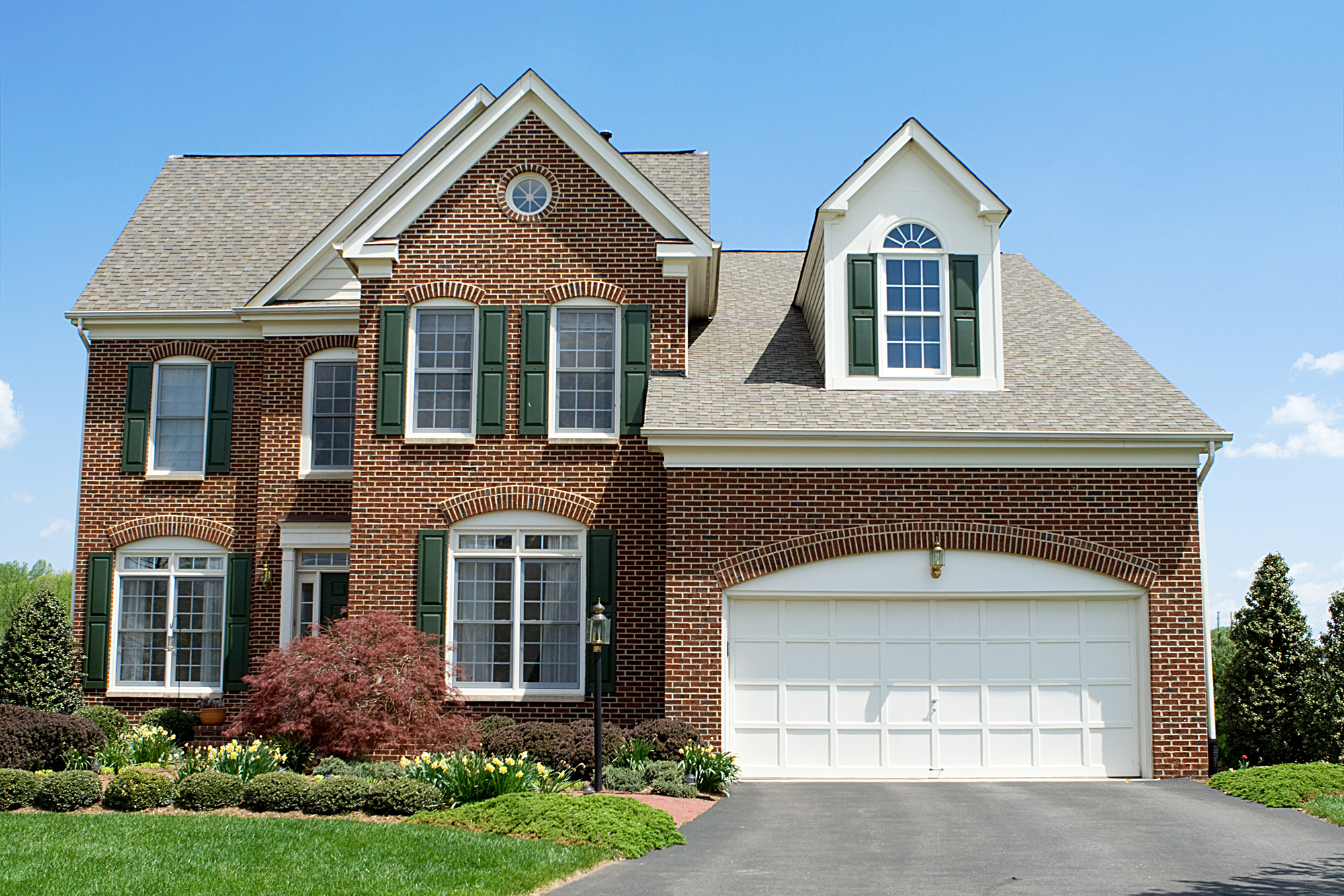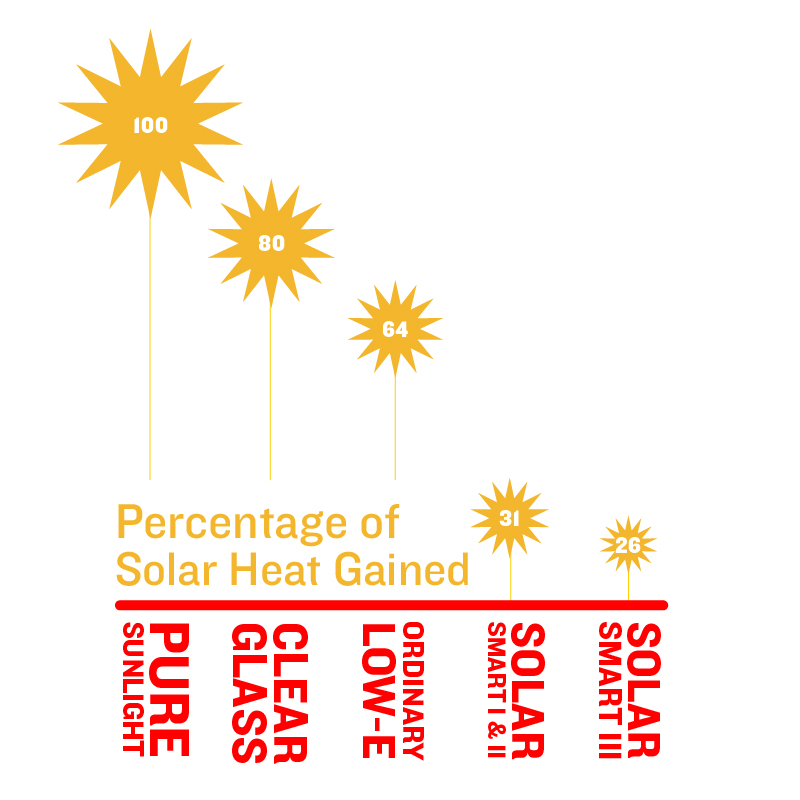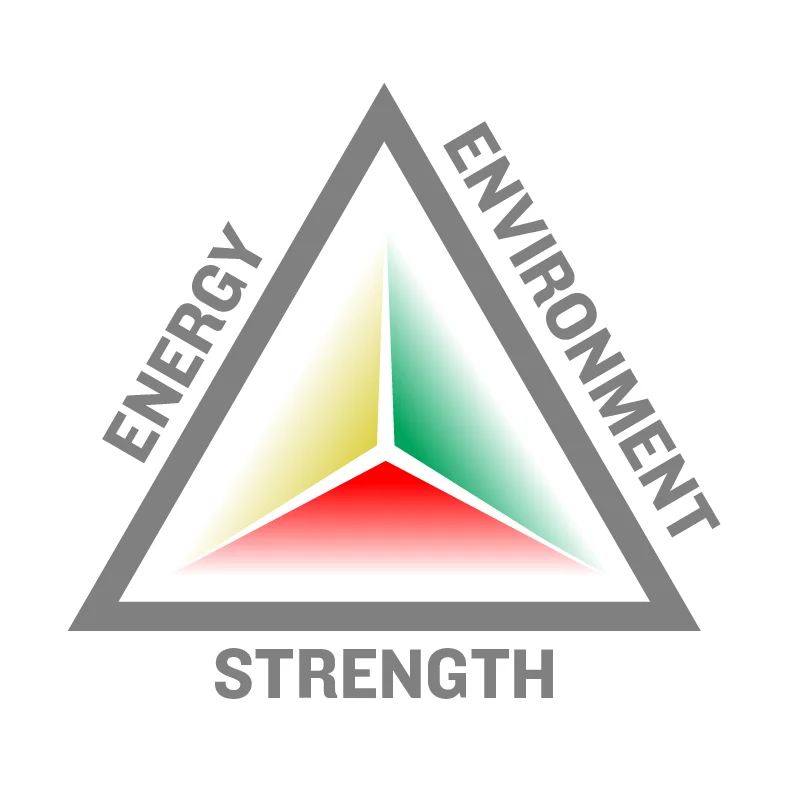Smart Glass Technology
Since over 80% of your window is glass, we’ve developed Smart Glass to allow you to choose the glass that best fits your budget and performance requirements. You need glass that is smart enough to block what you don’t want and allow what you do want into your home. Smart Glass does that. It blocks the sun’s heat without resorting to room darkening tinted glass. It also provides excellent insulation value in the wintertime, reducing heat loss through the window and reflecting the heat you’re producing back into your home. The heat you’re paying for is kept inside.
3 Components of SMART GLASS
Advanced Low-E Glass
Energy Smart (ES) Low-E glass is hard at work in the winter and summer to keep your home comfortable and save energy.
Solar Smart (SS) Low-E glass provides the same wintertime insulation benefits with an extra measure of solar protection in the summer.
Warm Edge Spacers
Intercept Spacer - extremely durable U-Channel spacer is cushioned by hot melt butyl seal creating a warm edge minimizing heat transfer.
SmartSpacer - Insulating silicone foam spacer provides the warmest edge temperature in the industry, up to 16 degrees warmer than other spacers.
Gas that pays you back
Argon gas is an odorless, non-toxic gas that is denser than atmospheric air. By displacing the air in insulated units with Argon, insulation value is improved by as much as 10%, and can also reduce convection.
It pays to be ENERGY SMART
Energy Smart glass improves the u-value and condensation resistance of the entire window unit. That means dollar savings through lowering heating and cooling costs, as well as more comfortable conditions in your home. For more information about energy performance and ratings by series check out the links below.
Don't let the sun
wilt your savings
By using Solar Smart glass, you can drastically reduce the amount of solar heat entering your home. For southern climates, this is a great way to minimize the sun's effect on those summer cooling bills.
To see how our WeatherBarr products perform, take a look at our Energy Efficiency Ratings.
Vinyl & glass, together for weather
Why pair vinyl with all of this energy efficient glass? Energy performance! All parts are made from virgin Un-plasticized PVC (uPVC) to ensure the components stand up to the test of the elements. uPVC is thoroughly maintenance free. It requires no painting or finishing. Alternatively, wood can require significant maintenance over the life of the window.
We take care in our designs to ensure that the windows will perform to our strict guidelines and keep your home comfortable in the worst weather. uPVC is a warm material and does not readily conduct hot or cold. Alternatively, aluminum is an excellent conductor, which can lead to increased heat/cold transfer and potentially condensation.
The multi-chambered design of our vinyl windows adds significant insulation value the added pockets of “dead” air. All vinyl waste is recaptured and recycled to ensure that there is minimal impact on our environment.
Tri-Beam Reinforcement
Our innovative, non-conductive reinforcing is 191 times more efficient than steel and 730 times more efficient than aluminum. It’s strength keeps your windows performing under load and it is easily recyclable, which provides minimal environmental impact.
Energy Performance Ratings
The following NFRC ratings are based on the Energy Star Rating Version 7.0 for WeatherBarr products. For detailed NFRC ratings for each series click the series name.
Window Series
Energy Star
Energy Star is a joint program of the Department of Energy (DOE) and the Environmental Protection Agency (EPA). The Energy Star Program certifies many products including windows, doors, and skylights based on the resulting energy performance of those products.
The program seeks to identify the highest performing products in each category and make those brands more recognizable by consumers. Consumers should expect to save significant energy costs by choosing an Energy Star certified product. In Windows, Doors, and Skylights segment, Energy Star goes a step further by defining regional performance criteria based on local climates. Energy Star certified windows represent an excellent value for homeowners in both new construction and remodeling.
In addition to being an Energy Star Partner, WeatherBarr Windows and Doors is proud to offer an extensive line of products that are Energy Star certified for all areas of the country. Please browse the detailed performance numbers for Cornerstone Series or the Apex Series. For more information on Energy Star, please go to www.energystar.gov.
To be labeled as an ENERGY STAR product, the U-factor and SHGC (Solar Heat Gain Coefficient) ratings must be less than or equal to those established by ENERGY STAR. The following is the ENERGY STAR criteria established in October 2023:
What Is Insulated Glass?
Insulated Glass is the combination of two or more panes of glass sealed with air, or inert gas between the panes. The construction of an insulated unit is designed to help control energy transfer from outside to inside or vice versa. It accomplishes this by controlling:
Conduction – Heat flow through a solid material, i.e. window frame, or glass
Convection – Heat flow by the movement of a fluid or gas
Radiation – Energy transmitted from heat source (sunlight)
The selection of materials and the design of an insulated glass unit will determine how a unit can save energy. An Insulated unit consists of:
Spacer
Desiccant
Sealant
Airspace
Glass
Spacer
Spacers are the material used to separate the two panes of glass. Spacer can insulate by using materials that reduce the “conduction” from the outside pane of glass to the inside pane. Using metal systems where the metal does not touch the glass and is cushioned by a bed of sealant limits the conduction that can occur. Intercept Spacer is an example of this type of system. See Figure A.
FIGURE A - INTERCEPT Spacer
Some more dense materials that do not include any metal, like siliconized foam spacer, can further improve the inside pane’s temperature. Our SmartSpacer is an example of a foam spacer. See Figure B.
FIGURE B - SuperSpacer Unit
Desiccant
Desiccant is a drying agent that is inside the spacer material to absorb all of the initial moisture inside the unit.
Sealant
The two panes of glass must be hermetically sealed together using a bonding agent like hot-melt butyl, silicone, polysulfide, etc. The sealant bonds the inside pane to the outside pane and creates the sealed airspace which creates the insulation effect. The dead air space further lowers the conduction effect.
FIGURE C - Triple Glazed unit with SuperSpacer
Airspace
As stated above, the dead air improves the conduction effect. However, convection can occur, which is the air turning over inside the unit and raising or lowering the temperature of the inside pane based on the outside conditions. The convection effect is minimized by trying to maintain optimal spacer thicknesses based on the design of the unit. In general, a ½” airspace is proven to minimize the convection effect. To further improve the energy performance, the use of an inert gas like argon, or krypton, which is heavier than air, can greatly limit both the conduction and convection effects. To take it further, a “Triple Glazed” unit can combine three panes of glass and two airspaces for some of the best energy performance. See Figure C.
Glass
Most of the insulated unit is glass. The glass that is selected is the only component that can have an impact on all three types of heat transfer. The use of tinted glass, like bronze or gray, can absorb energy and not allow it to pass on to the inside of the house. Today's more prevalent glass technology is low emissivity glass, or Low-E.
Low-E glass is designed to reflect radiant heat and can be used to reflect heat outside in cooling climates or reflect heat inside in heating climates. Low-E is also referred to as spectrally selective, which means it selectively allows only certain waves to penetrate through the pane of glass. By controlling the temperature of the outside pane of glass, it not only reduces radiant heat gain or loss, but also minimizes convection and conduction by helping to maintain the ambient temperature. The images below are thermal photographs of a foam spacer unit with clear glass on the left and a foam spacer unit with low-e glass on the right. The greens and blues show cooler temperatures, while the yellows and reds represent warmer temperatures, demonstrating the ability of low-e glass to control the heat.
Thermal image of Clear Glass
Thermal image of Low E Glass
Inside WeatherBarr Windows
What makes WeatherBarr Insulated Glass?
Spacer systems
Low-E
Argon
Triple Glazed
WeatherBarr always uses great care when selecting the technologies and components that we use in the production of our windows and insulated glass. Because of this, our insulated glass performs excellent both in energy efficiency and durability, with failure rates significantly better than the industry average.
Spacer Systems
WeatherBarr is proud to offer two of the best spacer systems on the market.
Intercept Spacer
The Intercept warm-edge spacer system is an important part of an efficient window. The unique, tin-plated steel, U-channel design creates an effective thermal barrier to help reduce conducted heat loss through the window.
Typically the edge of the glass is the least efficient area of a window. Unlike ordinary spacers, Intercept spacers insulate the edge of the glass to keep that part of the window warmer and make it more energy efficient.
Under normal weather conditions, glass units expand and contract with temperature changes. In conventional insulating glass units, sealant (the material that holds the unit together) takes the stress of the flexing. This can cause seal failure and insulating gas loss. In an Intercept glass unit, the spacer flexes instead of the sealant, so it resists spacer movement and premature sealant failure.
SMARTSpacer
SmartSpacer is a thermoset structural foam that provides the warmest edge temperature in the industry. By increasing the edge temperature, the inside pane of glass stays closer to room temperature which will drastically reduce the appearance of condensation.
The properties of the foam also allow for some sound absorption, improved argon gas retention, and its flexibility allows the insulated unit to expand and contract without straining the seal. SmartSpacer also provides excellent durability with some of the most rigid product testing in the industry.
Argon Gas
Argon gas is an odorless, non-toxic gas that is denser than atmospheric air. By displacing the air in insulated units with argon, insulation value is improved by as much as 10%, and can also reduce convection. Argon gas is included in all of our Smart glass products.
Low-E Glass
Low-emissivity glass is designed to selectively allow radiant waves of energy through the glass. The ability to control how much radiant heat passes through the glass allows an insulated unit to have a dramatic impact on the energy performance of a window.
Cardinal Low-E 270 is a very high performing glass used in our Energy Smart series of Smart Glass. Energy Smart Low-E uses 2 microscopic layers of silver to keep the heat where you want it. ES Low-E glass reduces heat gain by 50% compared to ordinary glass and blocks 86% of harmful UV rays.
Cardinal Low-E 366 powers our Solar Smart series of Smart Glass. Solar Smart Low-E uses 3 layers of silver to maximize the energy efficiency of your window. SS Low-E glass reduces heat gain by 64% compared to ordinary glass and blocks 95% of harmful UV rays.
Triple Glazing
For the ultimate in energy performance, our Energy Smart III and Solar Smart III utilize triple glazed insulated units. The units are sealed with SmartSpacer technology in both airspaces, as well as two coats of low-e on both the outside and inside, and argon gas in both cavities. The use of these packages will perform at the R-5 level and beyond.



















